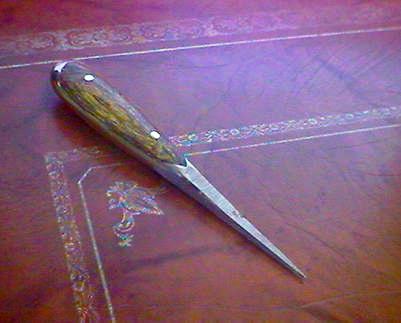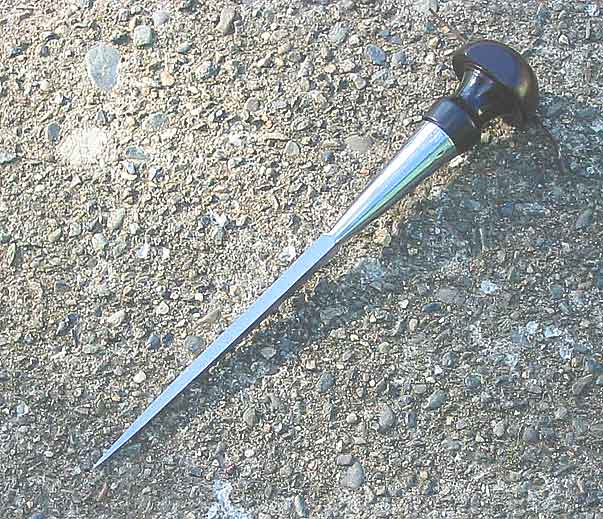It's pretty easy to fit those oval, curving inlayed scales (knife maker's
term), believe it or not. All of the smaller sizes were made to take 1/4"
stock. The larger (over 8" or so) take 3/8" stock. Pick an adequate supply
of your favorite wood.
The first thing you do is lay your frame down on the stock and trace around
it giving you a rough outline. Do this twice of course, once for each scale.
Next, saw the blanks out making sure not to get anywhere near the layout
lines you just made. You want some slop all around.
Now
you should have 2 oversize blanks. Here comes the first "trick".
Lay
your blanks on each side of the frame where they'll go. Pick the sandwich
up and place the whole magilla in-between the jaws of a heavy bench vice.
You will probably have to wiggle a bit under very light tension to make
sure everything lines up. You want a bit of overhang all around. When you're
satisfied, turn the crank. And again. Really reel on it. Heave. Smash the
wood into the frame.
If you've chosen a very hard wood it probably won't seat all the way down
in the frame no matter how hard you pull. In this case, before you release
the tension, mark the frame and handles so you can put them back on the
same side. They are not always identical. Remove the tool from the vice.
No matter how hard the wood, the frame shape will
have
dented it bigtime from the pressing. Rasp the scales closer to this dent,
but not all the way to it. Now replace it in the vice and press again.
This time they should seat all the way down.
Here
comes trick 2.
There
are 2 rivet holes in your frame from where the handles were attached in
the first place. Remove one of your new scales. Pick a drill bit the same
size as the rivets you will use that still will
pass
through the frame holes. I use brass brazing rod from the auto parts or
welder's supply. It comes in several sizes and its dirt cheap.
With
one handle removed, drill down through the frame holes through one handle.
Replace the second scale and drill back through the hole you just made
through the second one. Now everything will line up just dandy.
I
usually scrape the old frame clean where the handles live and place
a dollop
of 5 minute epoxy on each side. For your first one you might want to go
with slower setting glue. Reassemble (pay attention to your marks).
The old rule for rivets is twice the diameter sticking out of the work.
You can get by with less for this, maybe 1/16 inch on each side. I just
push the rod through and cut off what I need with a hacksaw. Lay it on
your anvil or other unyielding surface and peen. In case you never did
this part before, here's how it goes.
If
you just pound straight down on the rivets they'll eventually bend and
ruin your work. What you want to do is hit the top, outside edges of the
rivets alternating around the diameter. After several blows
turn
over and do the other side. Keep switching sides until the rivets
draw
all the way down with the handles pressed tight to the frame and glue squeezing
out.
Now you can rasp, file, scrape, sand to hand fitting oval perfection.
All
this seemed long to write and probably long to read too, but really, once
you have done one or two it's pretty fast.
For my regular screwdriver set (7 sizes) I used hard maple and black walnut
on every-other size. Looks pretty nice hanging up on the rack. I don't
think I originally paid over 50 cents for any of them.
Below are a couple more awls, one a
large sized perfect handle, or used to be anyway, in purpleheart and steel
rivets. The other made from an old socket chisel in rosewood. I saw socket awls
listed in an old Sargent tool catalog once.
yours, Scott |

 Perfect Handle Awl
Perfect Handle Awl

